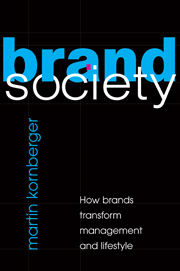Preface
Published online by Cambridge University Press: 10 January 2011
Summary
Proposition
Brands are a fait accompli. They are much exploited, but little explored. This book is about rectifying the ratio between exploiting and exploring through sketching out a theory of the brand society.
Why the brand society? On the most basic level, brands are a phenomenon that links and reorganizes the two fundamental spheres of production and consumption, which have been separated since the Industrial Revolution. Brands fundamentally transform how we manage an organization's identity, how we think of its culture and how we organize innovation. Simultaneously, brands transform the politics, the ethics and the aesthetics of consumption. Brands traverse society on the diagonal: following them means moving sideways, from production to consumption, from management to lifestyle, and back. Following this movement, the book turns into a treasure-hunt map rather than a surveyor's chart that measures a well-known, established territory.
Where to start? The good thing is that everybody experiences brands as part of their lives. That's also the problem: the things that are closest to us are often the most mysterious and unknown. When I started thinking about brands, I thought of products. Then, I tried to see them as images, as packaging, as a way of dressing things up that is certainly costly, maybe manipulative, but ultimately inconsequential because it's superficial. It was a thought by Mary Douglas and Baron Isherwood that, for me, suddenly turned brands into something else, something more: ‘Forget that commodities are good for eating, clothing, and shelter; forget their usefulness and try instead the idea that commodities are good for thinking; treat them as a non-verbal medium for the human creative faculty.’
- Type
- Chapter
- Information
- Brand SocietyHow Brands Transform Management and Lifestyle, pp. xi - xviPublisher: Cambridge University PressPrint publication year: 2010

